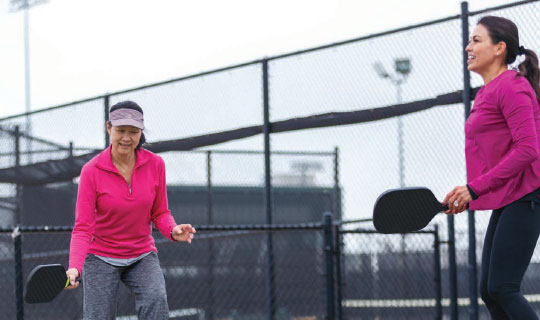
Pickleball is exploding in popularity—especially among seniors—with good reason. A combination of tennis, badminton and ping-pong, the game offers a great way to get relatively low-impact exercise and socialize with friends and neighbors.
But despite its low-key reputation, pickleball is a competitive sport with enough action to pose a risk of injury, according to orthopedic surgeons Raphael Longobardi, MD, of Cooperman Barnabas Medical Center, and Nicole Lopez, MD, of Clara Maass Medical Center. Dr. Longobardi is highly trained in sports medicine and athletic injury surgery, and Dr. Lopez is highly trained in hand and upper extremity surgery; both are members of RWJBarnabas Health Medical Group.

“Pickleball is really fun and played with a light ball on a smaller court than with tennis, so there’s less cutting and running,” Dr. Lopez says. “It’s generally very safe.” Yet the game’s low-impact appeal can make overdoing it deceptively easy.
“Most pickleball-related problems are overuse injuries such as lateral epicondylitis, or tennis elbow, and shoulder rotator cuff tendinitis,” says Dr. Longobardi.
Pain and inflammation from overuse injuries occur when repetitive motion causes tiny tears in tissues such as muscles, tendons and ligaments.
Players are also vulnerable to lower-extremity injuries such as ankle sprains, typically when lateral shifting causes an ankle roll. And falls can lead to wrist sprains or worse.
“It’s not common, but falling—especially if you have osteoporosis and sustain enough force—poses a risk of fracture,” Dr. Lopez says.
Still, there’s no need to let injuries (or fear of them) ruin the fun. These steps can keep you playing injury-free—or help you heal so you can get back on the court.
Know Your Limits
Many pickleball players are over 45, when loss of flexibility increasingly becomes an issue. “If you’re stiffer in your joints, there’s an increased chance of muscle strains,” Dr. Longobardi says.
Be mindful of your abilities when starting the sport or advancing your level of play.
“Take it easy the first couple of times to get your bearings and judge whether your body is able to do what you want,” Dr. Lopez says. “Once you’ve become accustomed to lower-level speed or agility, progress gradually to more intense or aggressive play—but always at the level your fitness allows.”
Prepare Your Body
“Injury prevention for any sport starts with being in good physical condition,” Dr. Longobardi says. “This means being not only flexible but also mobile and strong.”
Warming up with light activities such as walking and stretching also helps by not only making muscles and other tissues more pliable but also priming them for activity. “When muscles are awake and alert, you improve reaction time and can better respond to changes in direction,” Dr. Lopez says.

Try Simple Treatments First
If you incur an injury, it’s important to recognize it. “With many mild injuries, you feel a little ping of pain but are able to keep playing or walk away,” Dr. Lopez says. “Pay attention to your symptoms and ease up or stop playing until they improve or resolve.” Avoid playing through pain.
Many injuries improve with RICE—rest, icing, compression, evaluation. “Taking an anti-inflammatory medication is often helpful for twisting and overuse injuries,” Dr. Lopez says. (Discuss with your doctor before starting anti-inflammatory medications, as they can interact with medications commonly used to treat other medical issues.) Such injuries often take about two to four weeks to resolve.
Know When to Seek Help
Have a medical professional check you if you experience severe pain or bruising; notice that any part of your body seems deformed; or feel that your injury doesn’t improve or gets worse with self-care.
“Our purpose is to help people return to a level of activity that they haven’t been able to return to on their own,” Dr. Longobardi says. “We look at your injuries, what physical demands you have, what you’re looking to accomplish, what your recovery expectations are and when you can safely return to play.”
Look for Multidisciplinary Care
“We have a team of great people at RWJBarnabas Health,” Dr. Longobardi says. “If you need rehabilitation, we can send you to physical therapy. If you need surgery, we can provide that as well. Each member of our orthopedic and sports medicine team is well trained and has experience with these types of injuries.”
Consult Your Doctor About Surgery
Surgery for pickleball injuries is rare, partly due to lack of overhead serves that can lead to more severe injuries in sports like tennis. But surgical solutions may be appropriate in cases that don’t respond to more conservative measures.
“If we’re looking at a fracture that’s not setting properly, that’s often a reason we’ll recommend surgery,” Dr. Lopez says. “If you’ve tried all nonoperative options—including physical therapy, stretching and resting—and an injury is still giving you a lot of trouble, with imaging and the recommendation of a surgeon, a procedure might be an option.”
To learn more, visit orthopedic services at RWJBarnabas Health.
